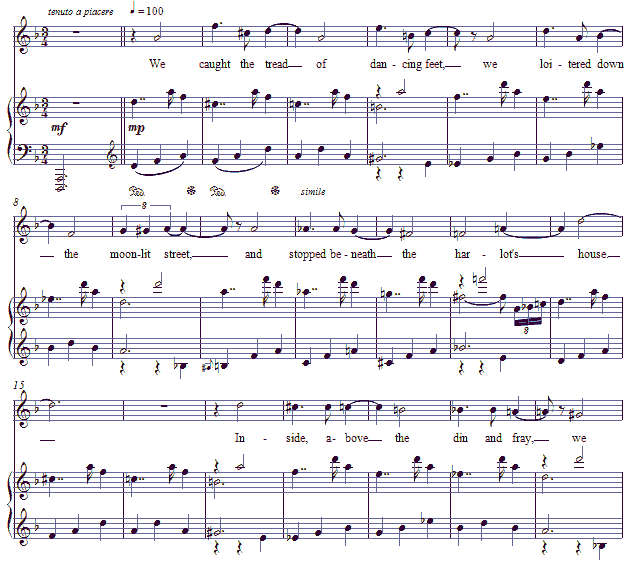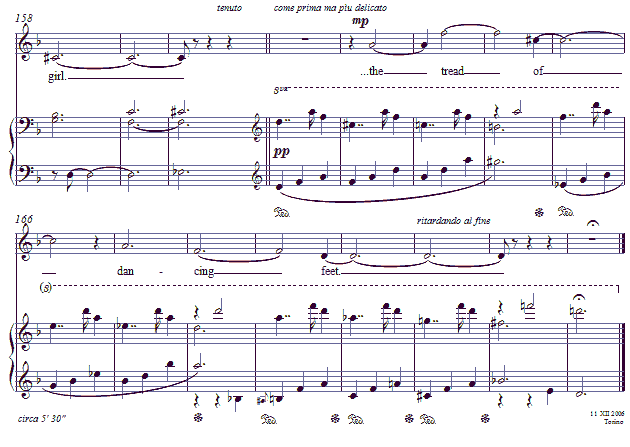Music and Texts of GARY BACHLUND
Vocal Music | Piano | Organ | Chamber Music | Orchestral | Articles and Commentary | Poems and Stories | Miscellany | FAQs
The Harlot's House - (2006)
Oscar Wilde
for medium voice and piano
We caught the tread of dancing feet,
We loitered down the moonlit street,
And stopped beneath the harlot's house.
Inside, above the din and fray,
We heard the loud musicians play
The 'Treues Liebes Herz' of Strauss.
Like strange mechanical grotesques,
Making fantastic arabesques,
The shadows raced across the blind.
We watched the ghostly dancers spin
To sound of horn and violin,
Like black leaves wheeling in the wind.
Like wire-pulled automatons,
Slim silhouetted skeletons
Went sidling through the slow quadrille.
They took each other by the hand,
And danced a stately saraband;
Their laughter echoed thin and shrill.
Sometimes a clockwork puppet pressed
A phantom lover to her breast,
Sometimes they seemed to try to sing.
Sometimes a horrible marionette
Came out, and smoked its cigarette
Upon the steps like a live thing.
Then, turning to my love, I said,
"The dead are dancing with the dead,
The dust is whirling with the dust."
But she--she heard the violin,
And left my side, and entered in:
Love passed into the house of Lust.
Then suddenly the tune went false,
The shadows wearied of the waltz,
The shadows ceased to wheel and whirl.
And down the long and silent street,
The dawn, with silver-sandalled feet,
Crept like a frightened girl.[ 7 pages, circa 5' 30" ]
The "house of the harlot" is often cited as referring in some manner to the house of Rahab, as found in the book of Joshua. For myself, I find this a bit too "academic." After all, Rahab is cast as a heroine of sorts, against the king of Jericho, as she hides the spies and defends them in her own ways. As is found in Joshua, "And the city shall be accursed, even it, and all that are therein, to the Lord: only Rahab the harlot shall live, she and all that are with her in the house, because she hid the messengers that we sent." [6:17]
Moreover this is reprised in the Christian scripture with which Wilde must have been acquainted. "And the city shall be accursed, even it, and all that are therein, to the Lord: only Rahab the harlot shall live, she and all that are with her in the house, because she hid the messengers that we sent." [James 2:25] To suggest therefore that Wilde's reference is to this harlot is ludicrous.
Rather, the citation in Revelation 17 might better serve, wherein the "woman" is cited as being named "Mystery, Babylon the Great" and "mother of harlots." Indeed this woman is mythic, as John writes "I saw a woman sit upon a scarlet colored beast, full of names of blasphemy, having seven heads and ten horns. And the woman was arrayed in purple and scarlet color, and decked with gold and precious stones and pearls, having a golden cup in her hand full of abominations and filthiness of her fornication. [17:3-4] It is far more likely that one like such a "harlot" is characterized in Wilde's poem, rather than the heroine of Joshua whose life is spared, long with those of her family.
Wilde chooses capitalization to denote Love and Lust as antithesis, as his "love" as found in the ninth strophe and in the lower case is then a representation of human "Love," set as the antithesis of "Lust." The theological import is obvious; "Lust" withers, while "Love" has the chance to survive. Perhaps as Wilde baptized to Roman Catholicism shortly before his death in Paris, this distinction was real for him, in spite of the more savory details of his life.
Most certainly Wilde's references to the dance of the dead -- or "danse macabre" -- is intended, as the image of shadows dancing -- as perhaps may be imagined backlit against the blinds in the third strophe -- becomes the shadows, as the "dead are dancing with the dead." The "danse macabre" or Totentanz has a long literary and art history, as generations dealt with the harsh realities of plagues, pestilence and war, expressing their anguish and fear through artistic vehicles.
Composed for a medium voice and piano, the setting opens with a deep single gesture, before the waltz begins. Various chromatic lines between the voice and piano accompaniment close in on one another, albeit not always in synchronous rhythms, through the survey of a strophe of three lines. The bit of "wrong note" music twists the waltz of couples in the harlot's house into Wilde's "danse macabre."
Several strophes are set to contrasting musical gestures before the reprise of the waltz "macabre." Though Wilde's poem ends with the end of the waltz as the dust "whirling with the dust" ceases, and dawn creeps into his scene, we know such scenes are repeated over and throughout generations, as we all must face some version of the Totentanz -- the dance of the living with the dead. As such, a reprise of the waltz theme and some of the opening text serves to remind us that the dance continues, even without us.
Along with settings of Wilde's Fantaisies Décoratives, this poem was set during my stay in Torino while working with the Teatro Regio.
The score for is available as a free PDF download, though any major commercial performance or recording of the work is prohibited without prior arrangement with the composer. Click on the graphics below for this piano-vocal score.

